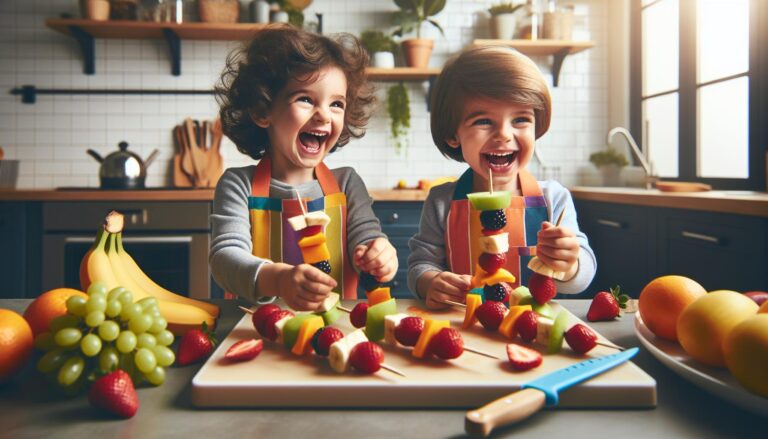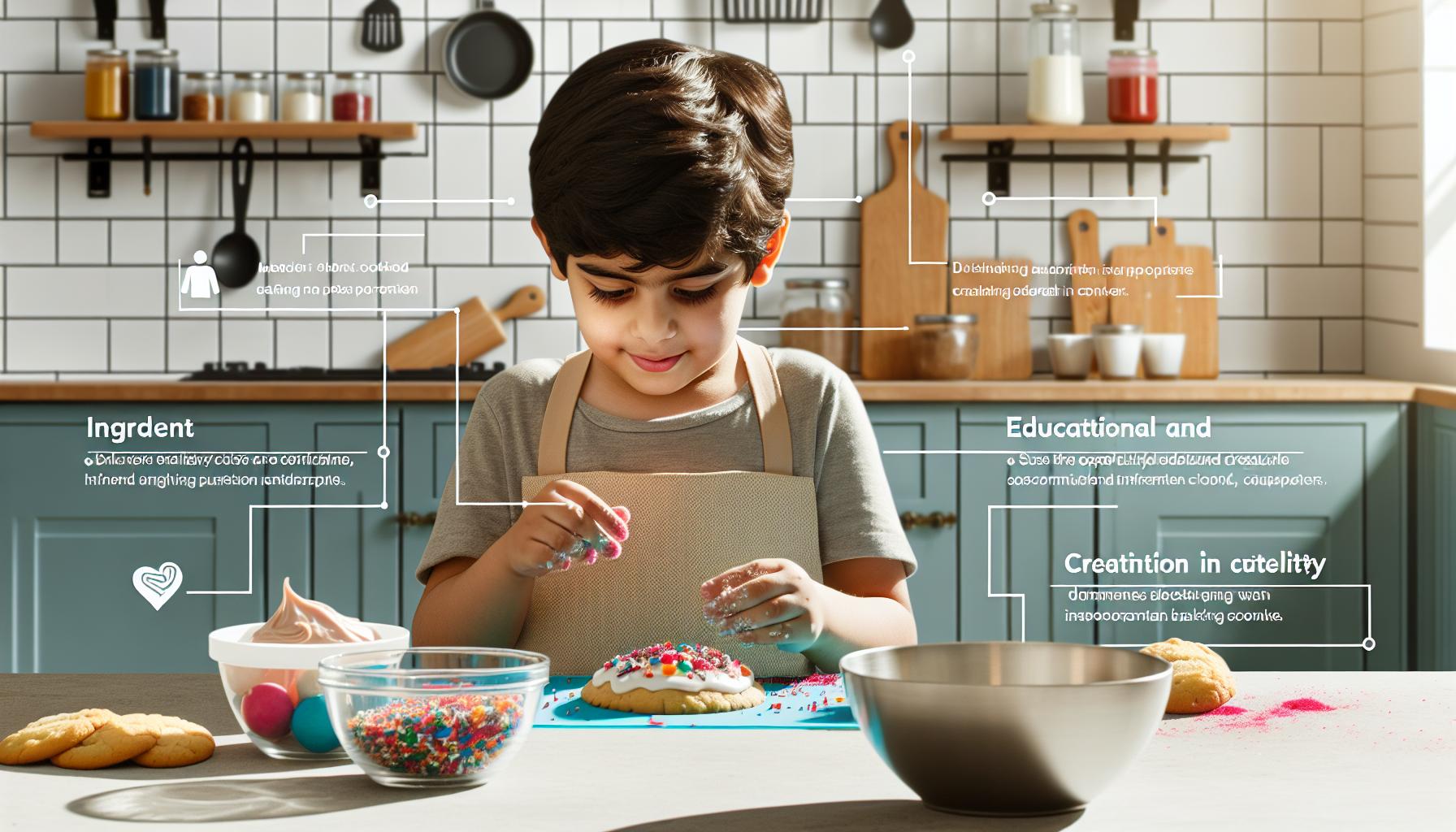
Cooking with kids offers more than just tasty treats – it’s a gateway to learning, creativity and family bonding. We’ve discovered that when children step into the kitchen they’re not just mixing ingredients; they’re developing essential life skills while having fun. From measuring ingredients to following recipes these hands-on activities help kids build confidence and independence.
Getting started with kid-friendly cooking projects doesn’t have to be complicated. Whether they’re baking classic cookies or decorating seasonal treats children of all skill levels can join in the kitchen fun. Have you ever wondered how baking can turn into an exciting educational adventure? We’ll show you how simple cooking activities can teach kids about kitchen science math and following instructions while creating delicious memories together.
Key Takeaways
- Cooking with children develops essential life skills including math, reading comprehension, and fine motor skills while creating meaningful family bonding experiences
- Kitchen safety is paramount – essential rules include proper hand washing, age-appropriate tools, and constant supervision levels based on the child’s age
- No-bake recipes like fruit kebabs and energy balls offer safe introductions to cooking for beginners while building kitchen confidence and creativity
- Themed cooking activities and holiday-inspired recipes make learning more engaging by combining culinary skills with seasonal celebrations and creative expression
- Kitchen science experiments transform cooking into educational opportunities by demonstrating scientific concepts through hands-on food experiments
- Creating a kid-friendly kitchen space with age-appropriate tools and proper organization is crucial for safe and successful cooking experiences with children
Why Cooking With Children Matters
Cooking with children creates meaningful learning experiences that combine fun with practical life skills. These kitchen activities offer opportunities for growth while strengthening family bonds.
Benefits of Teaching Kids to Cook
Teaching children to cook develops essential abilities that extend beyond the kitchen. Here’s how cooking enriches a child’s development:
- Builds math skills through measuring ingredients & counting steps
- Enhances fine motor development by stirring, pouring & mixing
- Boosts reading comprehension through recipe following
- Develops scientific thinking by observing food transformations
- Improves communication through recipe discussions & teamwork
- Creates cultural awareness by exploring different cuisines
- Strengthens confidence through completing cooking tasks
Essential Kitchen Safety Rules
Kitchen safety forms the foundation of successful cooking experiences with children. These fundamental rules keep young chefs protected:
- Wash hands with soap for 20 seconds before touching food
- Tie back long hair & wear clean aprons
- Use age-appropriate tools (plastic knives for young children)
- Keep handles turned inward on stovetops
- Maintain clear paths around cooking areas
- Clean spills immediately to prevent slips
- Store cleaning products in locked cabinets
- Use oven mitts for hot surfaces & containers
| Age Group | Recommended Activities | Supervision Level |
|---|---|---|
| 2-3 years | Stirring, pouring dry ingredients | Constant |
| 4-5 years | Measuring, simple assembly | Direct |
| 6-7 years | Basic knife skills, supervised stovetop | Close |
| 8+ years | Independent recipe following | Periodic |
Fun No-Bake Recipes for Beginners

No-bake recipes offer children a safe introduction to cooking without the risks of hot ovens or stovetops. These simple recipes let kids create delicious treats while building their kitchen confidence.
Colorful Fruit Kebabs
Creating fruit kebabs teaches kids essential food preparation skills through hands-on activities. Kids select fruits like strawberries, grapes, melon cubes or pineapple chunks to thread onto wooden skewers. This activity enhances color recognition, pattern-making skills and fine motor development as children arrange fruits in creative sequences. Adding yogurt dip transforms these nutritious kebabs into an engaging snack-making experience.
Energy Ball Treats
Energy balls combine simple ingredients into tasty no-bake snacks kids can shape with their hands. Here’s a basic recipe kids can customize:
Base Ingredients:
- 1 cup rolled oats
- 1/2 cup nut butter
- 1/3 cup honey
- 1/4 cup mini chocolate chips
- Coconut flakes
- Dried cranberries
- Chopped nuts
- Seeds
Kids measure ingredients, mix them in a bowl and roll the mixture into 1-inch balls. This hands-on process teaches measuring, mixing and shaping skills while creating portable snacks. The recipe adapts easily to different dietary preferences by swapping ingredients like sunflower butter for nut butter or dried fruit for chocolate chips.
| Age Group | Recommended Tasks |
|---|---|
| 3-5 years | Mixing ingredients, rolling balls |
| 6-8 years | Measuring dry ingredients, decorating |
| 9+ years | Complete recipe with supervision |
Easy Baking Projects Kids Love

Baking engages children in hands-on learning while creating delicious treats. Each project combines creativity, basic kitchen skills and fun activities to keep young bakers excited and motivated.
Cookie Decorating Adventures
Cookie decorating transforms basic sugar cookies into edible works of art. Kids practice fine motor control by spreading icing, sprinkling toppings and creating patterns. Pre-measured ingredients eliminate guesswork while individually packaged components make cleanup simple. Setting up decorating stations with different colored frostings, sprinkles and candies lets children experiment with designs. Fun illustrations guide kids through each decorating step, teaching essential techniques like flooding, piping and adding details.
Mini Pizza Creations
Mini pizzas offer infinite possibilities for personalization and creativity. Kids select toppings, learn about food combinations and practice spreading sauce evenly. Breaking down the process into clear steps helps children:
- Roll out individual portions of dough
- Spread sauce in circular motions
- Arrange cheese and toppings in patterns
- Create faces or scenes with vegetables
- Learn safe handling of ingredients
The hands-on nature of pizza making teaches:
- Measuring ingredients
- Following recipe sequences
- Kitchen safety practices
- Food preparation skills
- Creative expression through food
Tables with pre-portioned ingredients make assembly straightforward. Clear instructions with illustrations guide children through each step. Themed activities complement the baking process by incorporating games, puzzles or creative challenges related to pizza making.
Themed Cooking Activities
Themed cooking activities transform regular recipes into exciting culinary adventures for children. These creative projects combine imagination with hands-on learning to make cooking more engaging and memorable.
Rainbow Food Projects
Rainbow-themed cooking projects teach children about different fruits vegetables while creating visually appealing dishes. Here are 3 colorful activities:
- Layer vibrant fruits in mason jars to create rainbow parfaits with yogurt strawberries blueberries kiwis oranges
- Arrange vegetables in rainbow order on sheet pans to make roasted rainbow chips using sweet potatoes beets carrots zucchini
- Mix natural food coloring into pancake batter to create rainbow pancake stacks perfect for breakfast or snack time
Holiday-Inspired Recipes
Holiday cooking projects connect children to seasonal celebrations through festive food preparation. Here’s a selection of holiday-themed activities:
| Holiday | Recipe Idea | Key Skills Learned |
|---|---|---|
| Halloween | Monster cookie faces | Decorating creativity |
| Christmas | Gingerbread houses | Building structure |
| Valentine’s | Heart-shaped sandwiches | Basic knife skills |
| Easter | Nest cookies | Measuring dry ingredients |
Kids can:
- Shape sugar cookies into holiday symbols like stars hearts eggs
- Decorate cupcakes with seasonal colors red green for Christmas pink red for Valentine’s
- Create edible art using themed cookie cutters sprinkles food coloring
- Design holiday gift packages with homemade treats wrapped in festive containers
- Color recognition exercises
- Pattern making opportunities
- Counting practice
- Shape identification
- Creative expression through food
Kitchen Science Experiments
Kitchen science experiments combine cooking with hands-on learning to showcase everyday chemistry and physics principles. These engaging activities transform simple ingredients into exciting demonstrations that teach children about scientific concepts through observation and experimentation.
Edible Learning Activities
Food-based experiments offer tasty ways to explore scientific principles. Create colorful layered density tests using honey, dish soap, water, and oil to demonstrate how liquids stack based on their molecular weight. Mix baking soda with vinegar in a clear glass to observe chemical reactions producing carbon dioxide bubbles. Make rock candy by dissolving sugar in water to learn about crystal formation and saturation points.
| Activity | Scientific Concept | Time Required |
|---|---|---|
| Liquid Layers | Density | 15 minutes |
| Fizzy Reactions | Chemical Reactions | 10 minutes |
| Crystal Growing | Crystallization | 7 days |
Food Chemistry Fun
Simple kitchen ingredients reveal fascinating chemical reactions. Watch cabbage juice change colors when mixed with acidic lemon juice or basic baking soda to learn about pH levels. Explore enzyme reactions by testing how pineapple juice affects gelatin’s ability to set. Make homemade ice cream in zip-top bags to demonstrate how salt lowers the freezing point of ice.
| Experiment | Materials Needed | Learning Outcome |
|---|---|---|
| pH Testing | Red cabbage, acids, bases | Understanding pH scales |
| Enzyme Action | Pineapple, gelatin | Protein breakdown |
| Ice Cream Science | Cream, salt, ice | Freezing point depression |
Creating a Kid-Friendly Kitchen Space
A safe kitchen workspace empowers children to explore cooking with confidence. Setting up designated cooking areas with proper tools creates an environment where kids can develop their culinary skills.
Age-Appropriate Tools
Young chefs need tools sized for small hands to cook safely. Here’s essential equipment for different age groups:
Ages 3-5:
- Plastic mixing bowls with non-slip bases
- Child-sized wooden spoons
- Silicone spatulas with short handles
- Plastic measuring cups
- Safety knives made from nylon
Ages 6-8:
- Rolling pins with adjustable rings
- Cookie cutters with grip handles
- Mixing whisks with cushioned grips
- Plastic cutting boards
- Kitchen scissors with rounded tips
Ages 9-12:
- Junior chef knife sets
- Digital kitchen scales
- Silicone oven mitts
- Metal measuring spoons
- Handheld graters with guards
Organization Tips
Clear organization creates a productive cooking environment for kids:
Storage Solutions:
- Label drawers with pictures for easy tool identification
- Store frequently used items in lower cabinets
- Place heavy items at child’s waist level
- Use clear containers for ingredients
- Install hooks at kid-height for aprons
Workspace Setup:
- Create a dedicated prep station at proper height
- Place a non-slip mat under mixing bowls
- Keep cleaning supplies within easy reach
- Set up a step stool with handrails
- Position garbage bins close to work areas
- Install cabinet locks on hazardous storage
- Use corner protectors on sharp edges
- Place electrical outlets away from water sources
- Mount fire extinguisher at accessible height
- Keep first aid supplies in visible location
Conclusion
Getting kids involved in cooking opens up a world of learning and fun that goes far beyond the kitchen. We’ve explored various creative cooking projects that make the kitchen an exciting classroom where children can develop essential life skills while having a blast.
By creating a safe cooking environment and choosing age-appropriate activities we’re setting our young chefs up for success. Whether they’re arranging colorful fruit kebabs conducting kitchen science experiments or decorating holiday-themed treats they’re building confidence and creating memories that will last a lifetime.
Let’s encourage the next generation of culinary enthusiasts by making cooking an enjoyable educational adventure. After all every moment spent in the kitchen with our children is an investment in their future independence creativity and joy of cooking.
Frequently Asked Questions
Why is cooking with kids important?
Cooking with kids develops essential life skills like measuring, following instructions, and kitchen safety. It also enhances math abilities, reading comprehension, and scientific thinking while creating meaningful family bonding experiences. These activities build confidence, independence, and cultural awareness in children.
At what age can children start cooking?
Children can start participating in kitchen activities as early as age 2-3 with close supervision. Begin with simple tasks like mixing ingredients or decorating cookies. As they grow older, gradually introduce more complex cooking activities while ensuring proper safety measures are in place.
What are some safe cooking activities for young children?
No-bake recipes are perfect for young children. Activities like making fruit kebabs, assembling energy balls, decorating cookies, and creating mini pizzas are safe and engaging. These projects allow kids to learn basic kitchen skills without the risks of hot appliances.
How can I make my kitchen child-friendly?
Create a designated cooking area with age-appropriate tools, such as plastic mixing bowls and safety knives for younger children. Label drawers, store frequently used items at child height, and install safety features like cabinet locks. Ensure proper supervision and maintain a clean environment.
What can children learn from cooking?
Children learn multiple skills through cooking, including math (measuring), science (chemical reactions), reading (following recipes), and creativity (food presentation). They also develop fine motor skills, communication abilities, and gain practical knowledge about nutrition and food safety.
How can I incorporate educational elements into cooking activities?
Use themed cooking projects like rainbow-themed foods to teach colors, holiday recipes for cultural learning, and kitchen science experiments to demonstrate scientific principles. Create counting games with ingredients and practice reading recipes together.
What safety rules should children follow in the kitchen?
Essential kitchen safety rules include washing hands before cooking, using age-appropriate tools, wearing appropriate clothing, keeping workspace clean, and maintaining adult supervision. Teach proper handling of ingredients and tools, and establish clear guidelines for kitchen behavior.
How can cooking help strengthen family bonds?
Cooking together creates shared experiences and memories while encouraging communication and teamwork. It provides quality time for parents and children to interact, share family recipes, and celebrate achievements together. These activities foster a positive relationship with food and family traditions.

